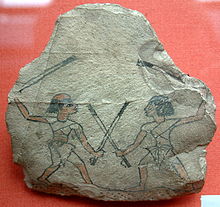
Back تحطيب Arabic التحطيب ARZ Tahtib Catalan Tahtíb Czech Ägyptischer Stockkampf German Esgrima con palos egipcia Spanish Tahtib French Taḥṭīb Italian タフティーブ Japanese Tahtib Portuguese
| This article is part of a series on |
| Life in Egypt |
|---|
 |
| Culture |
| Society |
| Politics |
| Economy |
|
Egypt portal |

Tahtib (Egyptian Arabic: تحطيب, romanized: taḥṭīb) is the term for a traditional stick-fighting martial art[1] originally named fan a'nazaha wa-tahtib ("the art of being straight and honest through the use of stick").[2] The original martial version of tahtib later evolved into an Egyptian folk dance with a wooden stick.[3][4] It is commonly described in English as a "stick dance", "cane dance",[5] "stick-dancing game", or as ritual mock combat accompanied by music.[6] Nowadays, the word tahtib encompasses both martial practice and performance art. It is mainly practiced today in Upper Egypt. Tahtib is regularly performed for tourists in Luxor[7] and Aswan.[8]
The stick used in tahtib is about four feet in length and is called an asa, asaya, assaya, or nabboot. It is often flailed in large figure-eight patterns across the body with such speed that the displacement of air is loudly discernible.
- ^ "Le tahtib, un Art martial égyptien pluri millénaire vivant". Egyptos.
- ^ "Tahtib". Akban Ninjutsu Academy.
- ^ "Tahtib and Egyptian Raqs al-Assaya: From Martial Art to Performing Art". www.shira.net.
- ^ "'Tahtib': The once martial art that turned into a dance". Retrieved 2018-05-08 – via DailyNews.
- ^ Michael B. Bakan, World music: traditions and transformations, McGraw-Hill, 2007, ISBN 978-0-07-241566-7, p. 279.
- ^ Biegman, Nicolaas H. (1990). Egypt: moulids, saints, sufis. Kegan Paul International. ISBN 9789061791225.
- ^ video Luxor Egyptian Stick Fighting (Tahtib) tourist exhibition
- ^ Lonely Planet (2009). The Cities Book: A Journey Through the Best Cities in the World. Lonely Planet. p. 54. ISBN 978-1-74179-887-6.